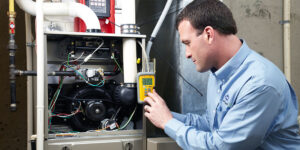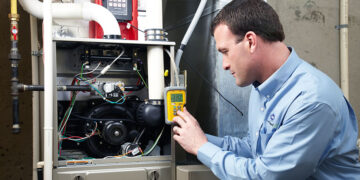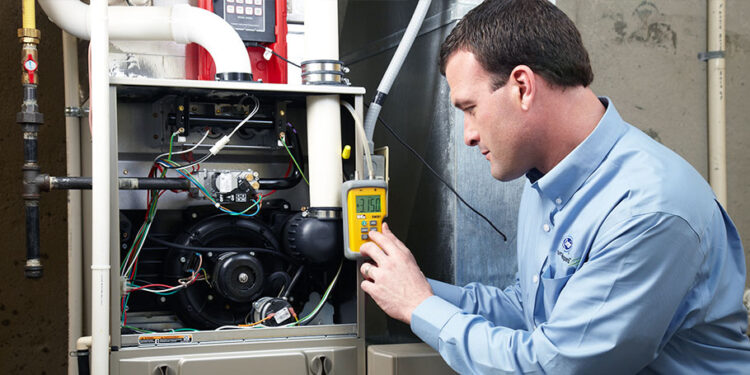Welcome to our ultimate furnace repair guide! Your furnace plays a crucial role in keeping your home warm and comfortable during the colder months. However, like any mechanical system, furnaces can encounter issues over time. In this article, we will walk you through troubleshooting common furnace problems and provide maintenance tips to help you keep your furnace in optimal condition. Whether you’re experiencing a malfunctioning furnace or want to be prepared for potential issues, this guide will equip you with the knowledge and tools to address the most common furnace Repair concerns.
Understanding Your Furnace
Before diving into troubleshooting, it’s essential to have a basic understanding of how your furnace works. Most residential furnaces operate on the principle of forced-air heating. They consist of a heat source, such as a gas burner or electric heating elements, a blower fan, air ducts, and a thermostat. When the thermostat detects a need for heat, it signals the furnace to ignite the burner or activate the heating elements, which warms the air. The blower fan then circulates the heated air through the ducts and into your home.
Safety Precautions
When working with your furnace, safety should be a top priority. Here are some important safety precautions to follow:
– Turn off the power: Before performing any maintenance or troubleshooting tasks, ensure the furnace is powered off. Locate the power switch or shut off the circuit breaker connected to the furnace.
– Allow the furnace to cool down: If the furnace has been running, give it sufficient time to cool down before attempting any repairs or maintenance. Hot surfaces can cause burns.
– Wear protective gear: When handling the furnace, wear protective gloves and eye goggles to protect yourself from sharp edges, electrical components, and debris.
– Keep the area clear: Ensure the area around the furnace is clear of flammable materials, chemicals, and clutter. Maintain proper ventilation to prevent the buildup of hazardous gases.
Common Furnace Problems and Solutions
No Heat
Possible Causes:
– Tripped circuit breaker or blown fuse.
– Thermostat set incorrectly.
– Pilot light or ignition system malfunction.
– Gas supply issues.
Solutions:
1. Check the circuit breaker and fuse box to ensure power is reaching the furnace.
2. Verify that the thermostat is set to the desired temperature and in the “heat” mode.
3. If you have a gas furnace, check if the pilot light is lit. If not, follow the manufacturer’s instructions to relight it.
4. If the pilot light is functioning correctly, but there’s still no heat, contact a professional to inspect the ignition system and gas supply.
Insufficient Heat
Possible Causes:
– Dirty or clogged air filters.
– Blocked or closed vents.
– Ductwork leaks or damage.
– Inadequate furnace size.
Solutions:
1. Check the air filters and replace them if they are dirty or clogged.
2. Ensure that all vents are open and free from obstructions.
3. Inspect the ductwork for leaks or damage. Seal any leaks or contact a professional for repairs.
4. If your furnace is undersized for your home, consult with an HVAC professional to determine the appropriate size for optimal heating.
Blower Fan Issues
Possible Causes:
– Motor or belt problems.
– Faulty fan control switch.
– Dirt and debris buildup.
Solutions:
1. Inspect the blower fan for any visible damage or obstructions. Clean away any debris.
2. Lubricate the motor and ensure the fan belt is in good condition. Replace the belt if it’s worn or damaged.
3. If the fan control switch is malfunctioning, contact a professional to replace it.
Pilot Light Problems
Possible Causes:
– Pilot light not staying lit.
– Thermocouple malfunction.
Solutions:
1. If the pilot light won’t stay lit, clean the pilot orifice and adjust the flame sensor.
2. Test the thermocouple using a multimeter. If it’s faulty, replace it according to the manufacturer’s instructions.
Strange Noises
Possible Causes:
– Loose or damaged components.
– Blower motor issues.
– Ductwork problems.
Solutions:
1. Inspect the furnace for loose or damaged components. Tighten or replace them as necessary.
2. Lubricate the blower motor if it’s making squeaking or rattling noises. If the noise persists, consider contacting a professional for further diagnosis.
3. Examine the ductwork for leaks or loose connections. Seal any leaks or contact a professional for repairs.
Thermostat Malfunctions
Possible Causes:
– Incorrect thermostat settings.
– Dead batteries.
– Wiring issues.
Solutions:
1. Verify that the thermostat is set to the correct temperature and mode (heat).
2. Replace the batteries if the thermostat is battery-operated.
3. Inspect the thermostat wiring for any loose or damaged connections. If necessary, consult a professional to rewire the thermostat.
Ignition Problems
Possible Causes:
– Dirty or corroded ignitor.
– Faulty ignition control module.
– Gas supply issues.
Solutions:
1. Clean the ignitor to remove any dirt or corrosion buildup.
2. Test the ignition control module using a multimeter. If it’s faulty, replace it following the manufacturer’s instructions.
3. If the gas supply is interrupted or insufficient, contact your gas utility provider for assistance.
Cycling On and Off
Possible Causes:
– Clogged air filters.
– Malfunctioning thermostat.
– Inadequate airflow.
Solutions:
1. Check and replace dirty or clogged air filters.
2. Test the thermostat to ensure it’s functioning correctly. If necessary, recalibrate or replace it.
3. Ensure there’s adequate airflow by keeping vents open and unobstructed.
Furnace Maintenance Tips
To keep your furnace running smoothly and efficiently, regular maintenance is essential. Here are some maintenance tips to follow:
Regular Filter Replacement
Regularly check and replace the furnace filters according to the manufacturer’s recommendations. Clean filters ensure proper airflow and prevent dust and debris from accumulating in the system.
Cleaning the Blower
Remove the blower assembly cover and clean the blower blades using a soft brush or cloth. Ensure the blower motor is free from dirt and debris to maintain optimal performance.
Checking and Cleaning Vents and Ducts
Inspect the vents and ducts for any blockages or obstructions. Remove dust and debris using a vacuum cleaner or a soft brush. Ensure all vents are open and unobstructed.
Lubricating Moving Parts
If your furnace has lubrication ports, apply a few drops of oil to the designated areas. This helps reduce friction and extends the life of the moving parts.
Inspecting and Cleaning the Flame Sensor
Inspect the flame sensor and clean it gently with a fine-grit sandpaper or a soft cloth. A dirty or malfunctioning flame sensor can cause the furnace to shut down or produce inadequate heat.
Testing and Calibrating the Thermostat
Periodically test and calibrate your thermostat to ensure accurate temperature readings. Consult the manufacturer’s instructions for specific calibration steps.
Checking Gas Connections
Inspect the gas connections for leaks or damage. If you smell gas or suspect a leak, immediately turn off the gas supply and contact a professional.
Clearing Debris around the Furnace
Regularly clean the area around the furnace, removing any dust, debris, or flammable materials. Maintain a clear space to ensure proper airflow and prevent potential hazards.
Hiring a Professional
While some furnace repairs and maintenance tasks can be done by homeowners, certain issues require professional expertise. If you encounter complex problems, gas-related issues, or if you’re unsure about performing repairs, it’s best to contact a licensed HVAC professional. They have the knowledge, experience, and tools to handle repairs safely and effectively.
FAQs
Q: How often should I replace the furnace filters?
A: It’s recommended to replace disposable filters every 1-3 months, depending on factors such as filter type, household dust levels, and pets. Cleanable filters should be cleaned according to the manufacturer’s instructions.
Q: Can I perform furnace maintenance if I have limited technical skills?
A: Basic maintenance tasks like filter replacement and cleaning vents can be done by homeowners with limited technical skills. However, for complex repairs or if you’re unsure, it’s best to consult a professional.
Q: Is it normal for my furnace to produce some odor during startup?
A: Mild odors may be normal during furnace startup due to accumulated dust or debris burning off. However, if you detect a strong, persistent, or unusual odor, it’s recommended to turn off the furnace and contact a professional for inspection.
Q: What should I do if my furnace is leaking water?
A: Water leaks can be caused by a variety of issues, including condensation, blocked drains, or a malfunctioning humidifier. Contact a professional to diagnose the problem and make necessary repairs.
Q: How can I improve the energy efficiency of my furnace?
A: To improve energy efficiency, ensure regular maintenance, keep vents clean and unobstructed, insulate ductwork, and consider upgrading to a programmable thermostat. Consulting an HVAC professional for an energy audit can provide further insights.
Q: How long does a furnace typically last?
A: The average lifespan of a well-maintained furnace is approximately 15-20 years. However, the lifespan can vary depending on factors such as usage, maintenance, and the quality of the furnace.
Conclusion
Maintaining a well-functioning furnace is essential for a comfortable home environment. By following the troubleshooting tips and performing regular maintenance outlined in this furnace repair guide, you can extend the life of your furnace and minimize the chances of unexpected breakdowns. Remember to prioritize safety, consult professionals when necessary, and keep up with regular maintenance to ensure your furnace operates efficiently and reliably for years to come.
Welcome to HVAC Champs, your go-to destination for all your heating, ventilation, and air conditioning needs. With our team of skilled professionals, we deliver outstanding HVAC services, installations, and repairs. Whether it's residential or commercial, we are dedicated to providing top-notch quality and customer satisfaction. Count on HVAC Champs for reliable solutions that keep your indoor environment comfortable and efficient. Your comfort is our priority, and we are ready to be your HVAC champions. Experience the HVAC Champs difference today at hvacchamps.com.













































